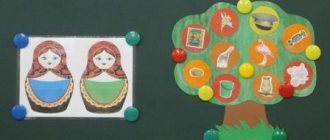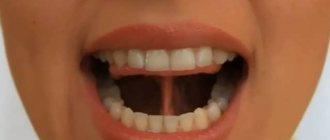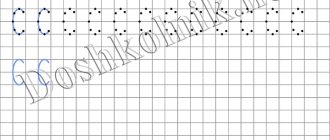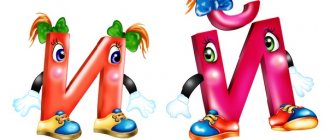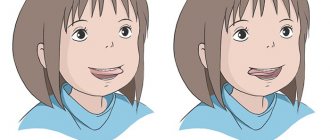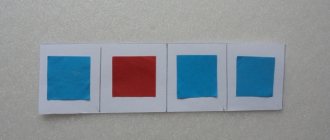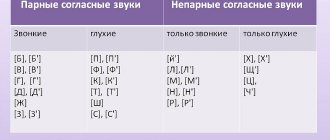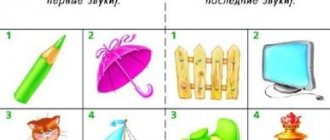Every person's speech consists of sounds. The child’s development depends on how correctly the letters are pronounced. If a child under 5–6 years old makes mistakes in reproducing phonemes, you should seek help from a specialist.
Recently, incorrect pronunciation of the letter D has become increasingly common among children. To eliminate the defect, the sounds “D” and “D” should be produced and automated.
Types of deviations
Characteristics of pronunciation defects:
Consonant voiced
Stun.
the sound “D” at different positions in words turns into
steam room
deaf
I agree
"T". The disorder occurs due to the similarity in the location of the articulatory apparatus during reproduction, poor development of phonemic perception and organic deficiencies of the speech organs. The defect is eliminated again using the phoneme “B”.- Open twang. Replacing the sound
“D” with “N”. The sky curtain is down. The tip of the tongue does not push away from the incisors. There is no push of the air stream from the oral cavity. The air leaves the nasal cavity in a continuous manner. - Clicking "D". Correction is carried out by regulating breathing during pronunciation.
You can check correct reproduction in the form of a small test, suitable for older
groups
of preschoolers
:
- An adult pronounces sentences with frequent letter repetition. For example, Dina blows a trumpet. The child is asked to repeat what he heard.
- Using illustrations of objects with the sounds “D” and “D”. Place the pictures
in front of the child. Ask to name what is depicted on them (oak, house, melon, children, hollow, etc.) - Search for the desired picture. The adult says the name of one depicted object among the presented pictures, and the child finds it and names it.
Such simple tasks are used in preparatory groups
to identify defects in sound pronunciation and to develop the thinking abilities of children. Similar activities are used for all types of phonemes.
III. DIFFERENTIATION OF PRONUNCIATION OF SOUNDS D - Дь
Sounds d
and
d
in syllables
1. Say a series of syllables.
du-du do-do do-du-du vdy-vde-vda
yes, yes, yes, yes, yes, yes, yes, yes, yes, yes, yes, yes, yes, yes, yes, yes, yes, yes, yes, but
2. Repeat rows of syllables (each syllable 3-5 times).
Di-dy-dy, di-dy-dy, ... etc. Dy-di-di, dy-di-di, ... etc.
Sounds d ch d v
words
1. Name words with sounds d
and
talk
from pictures or reflected (see dictionary on p. 79).
2. Name the pictures. Select from them those whose names contain the sound d, a
then - the sound
d. Arrange the pictures in two rows: with the sound d
and with the sound
d.
Ice floe, sofa, boards, dolphin, melons, smoke, swans, one, water, two, people, house.
3. Remember and pronounce a series of words, arrange pictures in the same sequence.
People, houses, melons, bears. Swans, turkeys, oaks, boards.
85
Sounds d
and
d
in phrases and sentences
1. Briefly answer the teacher’s questions based on subject pictures.
A person lives (where?) ... (in a house).
The fish swims (where?) ...
(in the water).
The squirrel lives (where?) ... (in
a hollow).
2. On the typesetting canvas there is a picture depicting one or two similar objects. The teacher asks: “Guess what word I have in mind. One …?" (one...? two...? two...?...?).
Sample. One oak, one board
etc. Lexical material:
oak, board, sofa, ice floe.
3. Repeat after the teacher the questions about the pictures and answer them in complete sentences, f Fig. 153-156.
Where did Vadik and Lida go? (To the cinema.)
Where did Vadik and Lida take Dima?
(Into the pool.)
Where did Vadik and Lida pour the water?
(Into the can.)
Where were Vadik and Lida sitting?
(On the sofa.)
Sounds d
and
in the texts
1. Learn the saying.
Two are not one - we won’t give offense.
2. Listen to the text and repeat it after the teacher. Answer questions about the pictures. " Rice. 157.
Houses for swans on the water. Two swans in the water. And two small swans on the boards near the house. Fedya and Dima threw crumbs to the swans.
Where are the swan houses? Where are the two little swans?
3. Listen to the text. Answer questions and learn the text. Name words from the text with the sound d,
and then - with the sound
d.
9 Fig. 158.
We have a bench in our kindergarten. We knocked it down from two stumps and one board. Let's sit on it and go home from kindergarten.
Where is the bench? What was the bench made of?
IV. DEVELOPMENT SOUND ANALYSIS AND SYNTHESIS SKILLS
1. Name the pictures: can, two, sofa. Perform word analysis. Choose from them the words that fit the scheme w
27.
2. Listen to the sentence Dima was at home.
Say words with the sounds
d
and
d.
Name the stressed syllable in these words.
What word can be made from the syllables do
and
ma, di
and lsh? What syllables are different in these words?
SOUNDS T, Т - Д, Дь
I. CHARACTERISTICS AND COMPARISON OF SOUNDS
1. Pronounce the sounds t, tp
and
d, d.
2.
Describe the sounds.
II. DEVELOPMENT OF PHONEMATIC PERCEPTION
1. Raise your hand when you hear the sounds d, d, a
then the sounds t, t “Ta, tya, dya, yes, du, du, you, ti, those, then, dy, di, tu, tyu, ...
2. Raise your hand when you hear the sounds d, d, d
and then - the sounds t,
t
I do, I blow, I stomp, I pull, I pull, I breathe, I give, I hold, I lose, I push, I catch up, I touch.
III. DIFFERENTIATION OF PRONUNCIATION OF THE SOUNDS T, Т - Д, Дь
Sounds
t, t and d, d in
syllables
1. Repeat rows of syllables.
| date | tee-dee | yes, yes, yes | di-ti-di | sta-zda |
| before | di-ti | to-to-to | to-do-to | vda-fta |
| doo-too | de-those | doo-too-doo | de-te-de | here |
| wow | te-de | you-you-you | ti-di-ti | who-where |
2. Repeat rows of syllables.
Ta-da-da, ta-da-da, ta-da-da, etc. Doo-too-too, doo-too-too, doo-too-too, etc.
3. Finish the last word in the sentence when listening again. —
At the station, passengers are waiting for food.
A bright light is burning in the sky. A burl is growing in the garden bed.
The album is missing one li(hundred).
Sounds t, t and d, d in
words
1. Game with Competition." Children are divided into two teams. Each team receives the same number of different pictures for the sounds t(t) i d(d) and completes the teacher’s task - to arrange the pictures into two piles with the sound t(t) and with the sound d(d). The teacher checks the results. The winner is the team that completes task A faster and without errors. 332-343.
Lexical material: house, board, oak, shoes, calf, swans dominoes, telephone, kitten, dishes, duckling, turkey, bus, cabbage sofa.
2. Listen to the sentences and pronounce words with the sound d(d), and
then - with the sound
t(t).
The gardener was planting bushes . Wild ducks fly south in the fall Mom buys Vadim dominoes. is lying on the sofa .
3. Change the words. Sample: Year - year.
Garden, bridge, cat, bush, factory.
4. Complete the sentences according to their meaning.
They built... on the mountain. In this house lives... After morning comes...
Volume
or
a house?
day or shadow?
Cool… falls from the trees to the ground.
5. Say the words, gradually accelerating the pace. The garden is the gardener, the tank is the tank driver.
6. Briefly answer the questions about the story picture. • Rice. 159.
Who's going with mom? Who did mom buy toys for? Whom is mom taking from the store?
Identify the stressed syllable in the words children, children, children.
Sounds t, t
and d, d in sentences
Causes of pronunciation problems
The occurrence of incorrect reproduction of soft and hard
"D" is accompanied by:
- lack of correct articulation
of the speech organs; - underdevelopment of phonemic hearing (the child does not distinguish sounds from each other);
- repeating the mistakes of others;
- weak motor activity of the lower jaw and other organs of the speech apparatus (occurs with dysarthria).
Note: dysarthria is a violation of the innervation of the speech organs. The deviation appears due to damage to the central nervous system.
It is possible to establish an accurate diagnosis and cause after speech therapy
examinations.
After collecting a detailed history, the speech therapist
prescribes corrective
tasks
. Some classes should be done at home.
Correct articulation for the sounds D and D
When playing the sound “D” the speech apparatus takes the position:
The lips are completely neutral. The production depends on the subsequent vowel phoneme. The distance between the lips and incisors is about 5 mm.- The tip of the tongue rests on the upper jaw. May touch the alveoli behind the upper teeth.
- The soft part of the palate descends.
- The larynx vibrates.
- The vocal folds are closed. Presence of voiceover.
The articulation of the soft “D” differs from the hard one only in the position of the tongue. Its tip falls behind the lower incisors.
Important: Classes aimed at establishing phonemes should be conducted after the child has mastered simple vowels and consonants (a, y, o, i, e, s) and (b b, p p, mm, v v, f f).
Exercises for staging
Before you begin to master the phoneme, you should go through the preparatory stage. It consists of performing special articulation and breathing exercises (here). The child must be taught correct articulation (position of the speech organs) and breathing during the pronunciation of an isolated sound.
Articulation gymnastics
The classes are designed to train the organs involved in the pronunciation of the sounds “D” and “D” description
:
- Lower jaw. Open your mouth wide. Use your lower jaw to imitate chewing movements. Perform for 10-15 seconds.
- Lips and cheeks:
- lips are closed, and air should be drawn into the oral cavity. Next, imitate rinsing as after brushing your teeth in the morning;
- use your lips to make characteristic sounds for a horse (snorting);
- pouting lips in turn. First the top, then the bottom.
3. Language:
Exercise "Mushroom"
- "Fungus". Smile widely with your mouth open. The flat tongue is sucked to the palate. In this case, the organ should be located behind the upper incisors. Hold the position for 10-15 seconds.
- "Horse". Click your tongue on the hard palate, imitating the sound of a horse's hooves.
- "Swing". Open your mouth wide, slightly exposing your teeth. Place the tongue behind the upper and lower teeth in turn. Performed 5 times.
4.Soft palate. The baby is asked to reproduce vowel sounds. The pronunciation is soft at first, and then a hard attack is applied.
Advice: to prevent your baby from getting bored with doing the same exercises, you can use classes prescribed for speech therapists. Many options are available on the Internet.
Breathing exercises
Experts suggest performing paradoxical gymnastics according to Strelnikova. But its use is allowed for children 7-8 years old ( grade 1
). Exercises should be performed under the supervision of parents or a specialist. Initial exercises:
- Palms. The child stands up straight. He bends his arms at the elbows and shows his palms to the adult. Hands clench into fists as you inhale and unclench as you exhale. You need to breathe through your nose. Perform the exercise 4 times.
- Shoulder straps. The baby is standing upright. Hands clenched into fists. They are pressed to the belt. While inhaling, hit the floor with your fists. Gradually unclenching your hands. As you exhale, return to the starting position. Do it 4 times.
- Pump. From a level stance, make a slight forward bend. The arms are hanging at the sides. Simulate tire inflation. Lean forward and inhale. As you exhale, return to the bent position.
Important: the technique has many contraindications, so you should consult a pediatrician before performing it.
To train children's breathing, use the “tube” exercise. The lips are pulled forward. Inhale through the nasal cavity, exhale a stream of air using a formed tube. Perform 4-5 times.
Techniques for producing sounds T D
The classic techniques of speech therapy work are the preparatory stage and sound production, which can also be actively used in home exercises. If you choose the right exercises, it will not be difficult for parents to cope with their child’s speech disorders.
Important: before teaching a child the correct articulation of the sound T ( D ), the adult must himself practice the position of the lips and tongue in front of the mirror: the lips take the position of the vowel that follows T (ta - ta - ta); the tongue is fixed in the upper teeth; the palate is raised. In addition, articulatory gymnastics must also be previously rehearsed by an adult.
Preparatory stage
Speech therapists insist that if the baby’s tongue is not strong enough to make sounds, it is necessary to first strengthen the muscles of the tongue and lips. Therefore, the preparatory stage necessarily includes articulation gymnastics. Speech therapy massage exercises will help prepare the speech apparatus for it::
- An adult, using a mirror, teaches the preschooler to take the correct position of the lips and tongue, showing the differences in pronunciation, for example, T (tip of the tongue) and K (tail of the tongue): “The cake is being eaten,” “Drops are dripping.”
- Making the T requires a sharp and strong exhalation. Therefore, it is necessary to develop the ability to exhale correctly. You can use the following exercises: “Soap bubbles”, “Balloon”, “Flying snowflakes (from a napkin or cotton balls)”.
- Then follows articulation gymnastics:
- “Wide smile” – connect your teeth, stretch your lips wide and hold this position for up to 7 seconds.
- “Tick-tock clock” - the tongue quickly moves left and right along the upper lip.
- “The tongue does not obey” - say five-five-five, tapping your upper lip on your tongue, gradually differentiating (distinguishing) the sounds P T.
- “Tongue - spatula” - relax the tongue, making it wide, place it on the relaxed lower lip.
Important: we must try to make it interesting for the child to complete rather monotonous preparatory tasks. To do this, it is necessary to introduce new articulatory gymnastics exercises, which can be borrowed from speech therapy practice, at each home lesson.
Staging sounds
How to install sound at home? Experts offer several ways to set sound; a parent can try all of them and choose the one that is more accessible and understandable to the baby.
- Setting T by imitation: an adult invites a preschool child to repeat first the syllables, and then the words; it is advisable to start with the syllable “ta”. For example: ta-ta-ta, ta-you-to-tu, you-you-you, you-ta-to-tu, to-to-to, to-tu-ta-you. Then the transition to words - pure words: ta-ta-ta, ta-ta-ta, such beauty; you-you-you, you-you-you, gave us flowers; tu-tu-tu, tu-tu-tu, we clean up; so-and-so, so-and-so, I put on my coat. A creative approach to speech activities will allow parents to independently compose similar phrases in sound, involving children in creativity.
- Interdental method: an adult shows the child the position of the tongue (the tongue is pressed between the lips, in this position you need to exhale strongly until you hear a sound, then place the tongue behind the teeth). You can teach how to control your exhalation by playing a “fence” for air by placing your palm in front of your mouth. Or arrange a game of “ball” (a cotton ball is driven into an improvised goal with a stream of air).
- Speech therapists use the method of setting T from the sound P. The child repeats pa-pa-pa, placing the wide tip of the tongue on the lower lip, then, smiling broadly, pronounces P , resulting in T.
- When setting D , the work is identical, only when exhaling the voice is added.
Automation of sounds T D
When the sounds T D are delivered (correct articulation has appeared) and the child learns to pronounce them, the next stage begins - automation (practice of the skill). It is important to achieve fluent pronunciation here. Since this is new for a preschooler, it means a lot of training is required. Speech therapists recommend introducing the practiced skill gradually: first through syllables, then words, then sentences. Articulation exercises, games based on poetry, stories, riddles will help well in this work, which will also maintain interest in the classes. At the same time, do not forget that every home lesson must begin with articulatory gymnastics.
Important: parents need to make every effort to ensure that the incorrect pronunciation of T D disappears from the child’s speech as quickly as possible. It should be taken into account that new material is introduced only after the previous one has been mastered.
What can an adult do to keep the child interested in activities and at the same time repeat monotonous actions over and over again? Gaming techniques will help, with the help of which syllables are practiced, for example: ta-ta-ta, yes-da-da, to-to, do-do-do, ta-you-to-tu, at-at-at, yes-dy-du, yt-yt-yt, ud-ud-ud. Plots can be very diverse:
- Let's teach the doll to brush its teeth, show it what articulation gymnastics is: “let's brush the teeth” (various movements of the tongue on the teeth from the outside and inside, up and down, left and right).
- Let's sing a song to the toys: “tra-ta-ta, tra-ta-ta, we are taking a cat with us”;
- Play the drum for the bear: tram-ta-ta-tam; on a dog pipe: doo-doo-doo.
- I start speaking, and you finish (the adult pronounces part of the word, which must end in a syllable with the sounds T D ): flowers, beauty, candy, mast, coat, bouquet; bicycles, sneakers, beards.
- Hello, little finger! (the thumb is put forward, and each finger in turn “greets it” with the syllables: ta, to, tu, you; yes, do, du, dy).
After the preschooler has automated sounds, the work becomes more complicated, the pronunciation of sounds is fixed in words.
Exercise “Collecting beads”
An effective exercise on automating the sound T with older preschoolers. An adult invites the preschooler to collect unusual beads, having previously agreed which syllable should follow which. For example, there may be such a sequence: that - that - you - that - that - that. Work with the sound d is carried out in a similar way. At first, you can rely on visual aids (colored beads, circles of colored paper, pencils). Subsequently, the visualization is removed, and the child acts from memory.
Exercise “Come up with words with the sounds T D”
Invite the child to repeat after the adult words with the sounds T D at the beginning, middle, and end of the word. For example, an adult starts with a more understandable syllable ta : ta kidneys, ta chka, ta reel; The baby continues: ta NK, ta Buret, ta Nets, ta Xi. Then he moves to another position T D : cat , cock , roll , leaf ; sala t , play t , collect t , bark t , help t . Or daughter , yes , day , gifts , soldier ( voice emphasis on the highlighted one). If at first it is difficult for a preschooler to continue his vocabulary, you can work with pictures. The work with the syllables you dy : you qua, hole , you , dy m; then to : then por, then mouth, then thick, kind , then chka, dochka ; tu du : tu chka, tu loop, ra du ga, du ga. It is better to prepare the vocabulary in advance. An even more interesting automation exercise will take place with a ball. The adult throws the ball to the child with his word, the child responds with his own.
Exercise “Sound t and sound d in a sentence”
Similar work is done with sentences; the preschooler repeats after the adult, emphasizing T D :
- Tanya and Tom are traveling on a tram.
- Trofim is riding in a taxi.
- The plane is flying.
- Aunt Tonya is planting flowers.
- Dima and Tolya are skating on the skating rink.
- Dasha and Denis shared the melon.
- Children go to kindergarten.
In order for a preschooler to be able to independently compose a sentence, plot pictures are used. It is necessary to ensure that all words of the sentence have a sound that is automated ( T D ).
Nursery rhymes, pure sayings for automating sounds etc.
To make it easy for parents to choose an artistic series for practicing the sounds of T D, you can use speech therapy selections or come up with pure sounding phrases together with your children. For example, the parent starts with syllables, and the child then rhymes the sentence:
- Ta-ta-ta, ta-ta-ta, (they saw a whale in the sea ) .
- Tu - tu - tu, tu - tu - tu, (let's pour some milk into it ).
- Yes - yes - yes, yes - yes - yes, (splashed all over with water ) .
- water in the glass ).
- Yes - yes - yes, yes - yes - yes, (don't go there ) .
- doo , (go there anyway ).
A lot of nursery rhymes can be found on children's websites or in children's books. Their main task is to automate the sound T ( D ), its correct pronunciation, for example:
Shadow, Shadow, Shadow, above the city there is a fence. The animals sat on the fence and boasted all day long. The fox boasted: I am beautiful to the whole world! The bunny boasted: Go, catch up!
Pull the canvases, the canvases are simple. Pull, Pull, Pull, Across, across.
We know, we know: Yes-Yes-Yes! Water is hiding in the tap! Come out, water! We came to wash up!
LaDushki, LaDushki, Let's bake pancakes. We'll put it on the window. Let's leave it to cool. Let's wait a little, Let's give pancakes to everyone.
Differentiation of sounds D T
An important stage in speech therapy work is the differentiation of sounds (distinguishing similar sounds, T D, D D, T T). This stage is carried out in parallel with automation and is necessary in order to compare sounds (soft and hard) and practice pronunciation. You can teach a preschooler new special techniques for distinguishing sounds: a hand is applied to the throat while sounding, the sound is determined ( D - voiced, voiced; T - deaf, without a voice). For differentiation, you can use already known techniques: syllables, words, sentences in exercises, games, sayings, nursery rhymes.
Differentiation of sounds T ТТ in the exercise “Compare sounds in guesses”
An adult asks the child to guess riddles, and then asks if the sound of T in all the riddles? The main thing is to make it possible to understand the difference in the pronunciation of the sounds T (hard) T (soft).
Round, not a month, yellow, not butter, Sweet, not sugar, with a tail, not a mouse ( you kwa).
He bows, bows, when he comes home he will stretch out ( then ).
A block froze over the water, and she dreams of fish for lunch. There are fins and too lazy to swim, the fish will be eaten by another ( seal laziness).
Exercise “Correct phrasing”
The goal is to teach how to pronounce and distinguish DY .
Grandfather Dodon played the pipe, Grandfather hit Danka with the pipe.
A woodpecker is chiseling a tree, Day after day crushes the bark.
Game "Come up with a proposal"
To establish and consolidate the pronunciation of T D , adults can teach children to come up with beautiful sentences while relying on verbal helpers. Then determine which words have hard T D and which have soft Т Дь:
Denis - telephone (Denis was given a telephone); Home is a cat (Our cat doesn’t walk, he’s at home); Tanya - melon (Tanya loves melon); Tyoma is a pipe (Tyoma learns to play the pipe); Dusya - pictures (Dusya loves to look at pictures);
Important: parents should understand that home exercises for correct pronunciation consist of developing the skill of pronouncing the sounds of their native language. This process is long, systematic, and requires patience and persistent training in automation and sound differentiation. A thoughtful selection of articulatory gymnastics, exercises, games, and verbal material will help to achieve good results in the development of competent, beautiful speech in preschool children.
Staging
It is carried out after the child has mastered the position of the speech organs when reproducing a phoneme. Typically, 2 methods of producing the sound “D” and “D” are used:
. The baby and the adult sit in front of the mirror. A parent or specialist demonstrates the correct pronunciation of the sound. The child is asked to repeat. To make it easier, vowel sounds are used. For hard “D” (da – do – du – dy), and for soft “D” (di – du – de).
Imitation- Mechanical method. The child pronounces the sound “B”. The tongue is between the lips at this time. The speech therapist uses a special spatula to press on the tip of the organ. Then he pushes it behind the upper incisors.
Experts often offer these methods of setting as homework.
. In a familiar environment next to a loved one, the baby will master classes faster.
Important: when performing exercises, point out the distinctive characteristics of the phoneme “D” from “T”. A special feature of the sound “D” is the vibration of the vocal folds. In order for the baby to feel the difference, his hand is placed on the larynx of an adult, who pronounces the letters in turn.
Material for automating the sound "D" educational and methodological material on speech therapy
Material on sound automation D.1. Repeat the syllables.
Yes, yes, yes, yes, yes, yes, yes, yes, yes
Yes-do-do-dy Do-do-da-do Do-do-dy-da
2. Repeat the words. The sound at the beginning of the word: Dam, give, lady, date, Danya, dacha, Dasha, distance, gift, free; smoke, melon, haze, haze, breath, breathe, hole, hole; don, house, house, dock, milking, daughter, domino, wash, get, finish, drink, top up, rain, road, good, doctor; oak, Dunya, duma, blow, arc, perfume, oak, think, shower, soul, stuffy, blew, blew, hollow, pipe.
Sound in the middle of the word: Food, water, trouble, weather, throw, Luda, medal, pedal, prowess, deck, dishes, freedom, settlement, environment, ore, blow, pencil, fence, joy, stage, obstacle, reward, fashion , berries, waterfalls, gardens, factories, trails, fruits, ponds; milk, whistle, walker, young; I’ll go, I’ll find, I’ll fall, air, inflated, sorcerer, put, rainbow.
Confluence of consonant sounds in syllables and words:
Two, two, bottom; food, dlo, dra, dro, other.
Two, twenty, twice; two, deuce, yard, janitor, mongrel, yard, palace; bottom, fashionable, tray, vessel, okay; surrendered, squeeze, give up; vile, meanness, breakdown; drama, fight, dragon, drape, drag, tease; fraction, crush, thrushes, tremble; friend, other, friends, squad, friendship.
3. Repeat the sentences. Dasha is at home. Danya at the dacha. The house has a shower. The lady is walking along the road. She has a melon. Dunya thinks: “I won’t fall.” Dasha has a hole in her dress. The road is visible in the distance. There is a woodpecker in the hollow. Danya received a medal. A janitor sweeps the yard. The wind is blowing outside. Dunya plays the pipe. There are a lot of berries near the pond. Danya and Dasha are picking berries. Dani has a dacha. The dacha is far away. Our home is on the Don. Don is a river. Ships are moving along the Don. There is an oak tree in the garden. The sorcerer built a palace. My daughter has a pencil. Danya and Dasha are friends. They don't have twos. In the forest you need to breathe fresh air. Luda, it's time to go home.
4. Repeat pure sayings.
Yes - yes - yes - the water is running. Doo - doo - doo - I will find you. Do - do - do - the beep sounds. Hey, hey, hey, the gardens are blooming.
5. Repeat proverbs and sayings. One for all and all for one. The fur coat is new, but there is a hole in the hem. You can’t even pull a fish out of a pond without difficulty. I walked through the forest, but didn’t see any firewood. They don't give anything for nothing. A quarrel will not lead to good things.
6. Repeat the tongue twisters. Daria gives Dana melons. Don, don, don - the cat's house caught fire. Oh, doo-doo, doo-doo, doo-doo - I’ll find you anyway.
Sound in the middle of the word: Food, water, trouble, weather, throw, Luda, medal, pedal, prowess, deck, dishes, freedom, settlement, environment, ore, blow, pencil, fence, joy, stage, obstacle, reward, fashion , berries, waterfalls, gardens, factories, trails, fruits, ponds; milk, whistle, walker, young; I’ll go, I’ll find, I’ll fall, air, inflated, sorcerer, put, rainbow.
Confluence of consonant sounds in syllables and words:
Two, two, bottom; food, dlo, dra, dro, other.
Two, twenty, twice; two, deuce, yard, janitor, mongrel, yard, palace; bottom, fashionable, tray, vessel, okay; surrendered, squeeze, give up; vile, meanness, breakdown; drama, fight, dragon, drape, drag, tease; fraction, crush, thrushes, tremble; friend, other, friends, squad, friendship.
Rainbow-arc, rainbow-arc - don't let it rain!
7. Repeat the riddles. He makes noise in the field and in the forest, but doesn’t get into the house. And I won’t go anywhere while he’s walking. (Rain)
A white pillar stands on the roof and grows higher and higher. So he grew to heaven - and disappeared. (Smoke)
New dishes, but all with holes. (Sieve)
There is a mountain in the yard, and water in the hut. (Snow)
There is water all around, but drinking is a problem. (Sea)
8. Learn a poem.
Animal trainers! Give me some sugar quickly! For a long time the animals taught you so that they could be given a reward. (V. Berestov)
9. Game “Give me a word.”
An adult invites the child to listen to poems and suggest the right word at the end of each of them.
Our boy walks with difficulty, For the first time he walks around... (house).
Rain! Rain! We need to go to... (homes).
I will sew him new legs, He will run along... (path) again.
10. Game “Name it kindly.”
The adult asks the child to affectionately name the following objects: House - (house) pipe - (pipe) Oak - (oak) hole - (hole) Road - (path) smoke - (smoke)
11. Game “Be careful.”
The adult invites the child to listen to the story and name all the words with the sound D that appear in it.
Here is Aunt Lyuda's house. The house has a garden. Aunt Luda is a gardener. Apple trees, plum trees, and raspberries grow in the garden. Aunt Luda loves to take care of her garden. In autumn she collects a lot of fruits. Aunt Luda distributes apples, plums, and raspberries to her friends.
